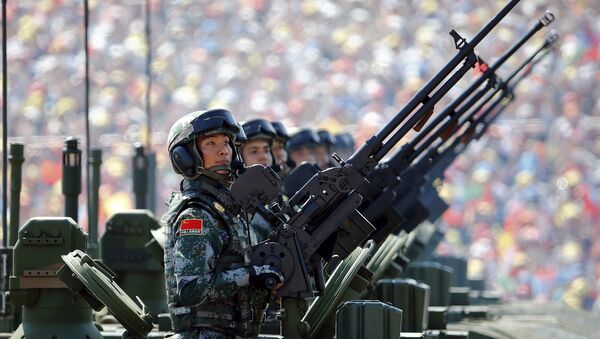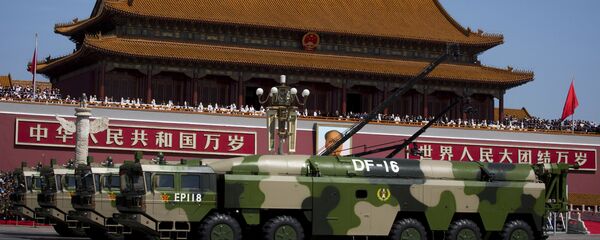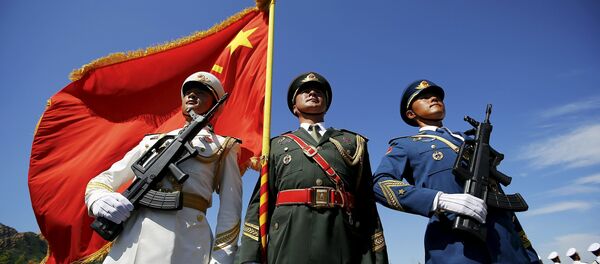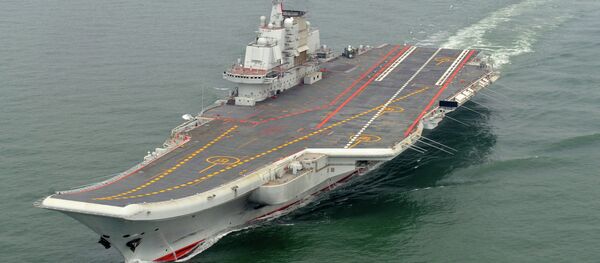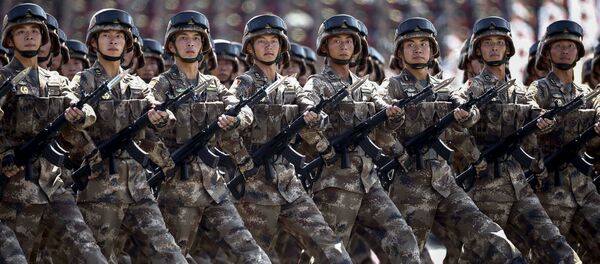Fu Ying, a spokesperson of the country’s National People’s Congress (NPC), made the announcement on Saturday.
"This year, the defense budget will increase by about seven percent and will amount to 1.3 percent of the GDP," Fu Ying said at a press conference.
Commenting on the factors behind the planned increase, she stressed that it is due to a need to ensure state security and is not a reflection of opposition to other nations.
China’s Military Budget
In recent years, Chinese military spending has slowed down due to a downturn in the industrial sector. In 2015, China’s defense budget increased by 10.1 percent against the previous year, while in 2013 – by 12.2 percent, in 2012 – by 11.2 percent and in 2011 – by 12.7 percent.
Meanwhile, Lt. Gen. Wang Hongguang, a retired deputy commander of the former Nanjing Military Command, called for a 12 percent increase in the Chinese defense budget in view of US defense-spending plans.
"The US defense budget has increased by 10 percent and we need at least a double-digit increase. The most ideal is 12 percent," Wang was quoted as saying by South China Morning Post.
To a certain extent, Wang’s proposal is reasonable because he insists that China’s defense budget should be based on actual military needs.
Currently, Beijing spends on defense some 1.3 percent of GDP, which is significantly less than in many other countries. In particular, Russia’s military budget accounts for around 4.5 percent of GDP and is planned to be reduced to three percent. The US spends slightly more than three percent of GDP on defense. Within NATO, there is a target of two percent of GDP.
According to estimates based on the 2014 dollar-yuan exchange rate, in 1989 China’s military budget was $20.2 billion, in 1990 — $22 billion, in 1992 — $28.4 billion, in 1997 — $29.9 billion and in 1998 — $32.7 billion.
In 2000, China saw an explosive growth in military spending. In 2001, it increased by 17 percent (from $43.2 to 52.2 billion). In 2002, China’s military budget reached $60.6 billion and in 2007 topped $100 billion.
Eight years later, Beijing’s military spending doubled. In 2015, it reached $214.5 billion. Therefore, in a quarter-century, China’s military budget has increased tenfold.
China’s Armed Forces
As for the beginning of 2017, China had 2.335 million active military personnel, according to data from Global Firepower. As a comparison, the US has 1.4 million ready-to-fight personnel, India – 1.325 million and Russia – 766,000.
Meanwhile, the technical capabilities of the Chinese People’s Liberation Army (PLA), which include a considerable number of military hardware units and weapons from the 1970s and 1980s, leave much to be desired. For comparison, the Russian Armed Forces have in service 15,000 tanks (China has 9,000), 31,000 armored vehicles (China, 4,700) and nearly 6,000 self-propelled guns (China, 1,700), according to Global Firepower.
However, Beijing’s arms imports data reveal that the Achilles’ heel of its defense industry is helicopters and missile defense.
Analysts have estimated that complete mechanization of the Chinese military will take at least 10-15 years.
It is commonly supposed that China lags behind the US and Russia in terms of strategic nuclear forces. However, all information about the PLA Rocket Force (or Second Artillery) is classified.
Certain media reports say that China has over 240 nuclear warhead (the US and Russia has 1,700 each), and the number could increase to 400 by 2020. There are 24 nuclear industrial facilities and 12 missile-assembling factories in China.
The Chinese strategic forces have many types of missiles in service, including short-range, medium-range and intercontinental ballistic missiles (ICBMs). The PLA Rocket Force includes six rocket armies deployed to six military districts.
The Chinese naval aviation was also seriously modernized. In 2012, China’s first aircraft carrier, the Liaoning, was commissioned. The ship was originally laid down as a Soviet multirole aircraft carrier under the name Riga and then Varyag. China bought it from Ukraine for $25 million.
Currently, Beijing is developing its own aircraft carrier program. By 2020, the Chinese naval forces are expected to receive several native aircraft carriers.
Geopolitical Standoff
In the Russian expert community, there are two opposite views on what geopolitical gains China expects from investing in its military potential.
The second angle is that China needs a capable military for standoff against the US. Tensions between Washington and Beijing will further deepen and China is focused on strategic partnerships with Russia.
In an interview with RT, Vadim Kozyulin, a professor at the Russian Academy of Military Sciences, noted that China has turned into the main geopolitical rival of the US.
"This can be illustrated with [US President Donald] Trump’s hardline remarks about China. He understands the situation and can see that the US and its allies are now being squeezed from the Asia-Pacific region," Kozyulin said.
The expert pointed out that now "we’re witnessing struggle for control over the South China Sea." He also suggested that tensions in the region will grow deeper because the US plans to increase the size of its naval forces from 272 to 350-355 ships.
"Beijing understands of the upcoming standoff and pays attention to modernization of all components of its military," Kozyulin said.
Passionless Response
The announcement of an increase in China’s military spending came earlier this week after the US Office of Management and Budget (OBM) announced that US President Donald Trump’s budget proposal would boost military and security spending by $54 billion, or 10 percent, with a corresponding reduction in all other discretionary spending.
Meanwhile, according to Jin Cairum, an expert of the Institute of International Relations at the Chinese People’s University, the boost in military expenditures in the US and China will not result in an arms race.
"The money [US additional military spending] will be mostly spent to increase welfare and assistance for servicemen, rather than to buy new military hardware. Moreover, US military spending will not be concentrated only on the Asian-Pacific region," the expert told Sputnik China.
He continued: "China’s reactions should be passionless. The situation is that the US and China are increasing their military budget at the same time. This is not an arms race."
Never miss a story again — sign up to our Telegram channel and we'll keep you up to speed!

